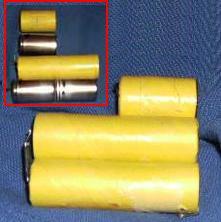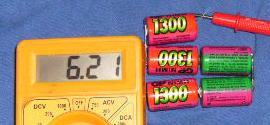Just to prove that not only hair clippers can be re-celled, here is a rechargeable battery pack from a scanner with non-consumer sized cells fitted. An easy job (except for the glue!) and radio related too!

I had an enquiry at a radio club meeting about re-celling a battery pack for a Uniden scanner (a BP2500, suitable for the UBC-2500/3000XLT scanners), as it no longer held a charge for long. The data label on the pack stated that it was 6 V at 600 mAh and, as I looked at the pack which seemed to only be clipped together, I thought I'd take a look at it there and then.
While the pack seemed to just be clipped together it was a right swine to open! I discovered that when it had been built both sides of the case had had a liberal squrit of, what seemed to be, Evo-Stik contact cement that was not only holding the cells in place so that they didn't "rattle about" but both sides of the pack together too! It did give way after a bit of a struggle so, eventually, I was in.
On further study of the pack later, I realised that the slide runners that held the pack to the radio were on one half of the case while the other half and cells are only held in place by the little plastic clips and glue. See? Manufacturers do things for a reason!

Inside there is a charging socket and charging circuitry, mounted on a small circuit board, as well as the set of cells, encased in thin cardboard tubes and covered with heat shrink plastic (main image right, heat shrink plastic removed), 5 cells in total (1.2 V × 5 = 6 V). The cardboard tubes were purely for insulation as the cells were bare (inset shows tubes and cells). I also removed all the glue residue.
Once at home I measured the cells I found them to be 2/3 A sized cells (often called 2/3 AF) and a quick search on the internet found replacement tagged cells of 1300 mAh capacity for £2.25 each from Strikalite. With postage the total cost for the 5 cells was £12.90. A quick phone call to Strikalite confirmed stock availability. I had ordered from Budget Batteries (cheaper price but for 1100 mAh cells) and, while their website said they had stock, an email 24 hours after order informed me they were out of stock, with a 3-4 week delivery time! The pack's owner confirmed that he was happy with the extra cost and capacity from Strikalite and the cells were ordered on-line Friday lunchtime, with the auto cofimation of order email telling me that I would be emailed when despatch occurred. Monday afternoon I had the "despatched" email and Tuesday morning the cells arrived. Well done Strikalite.

I set about the rebuild and noted that the original pack had, what seemed to be (and is not unusual) a thermal fuse between 2 of the cells. I removed this and, on checking with a meter, I discovered that it would pass current (but only in one direction?). As it was obviously fitted as some kind of safety device (it may still have thermal properties) I fitted it as it was originally placed in the new pack checking, of course, that it was the correct way round (I did wonder how this would affect charging but, on test, the pack charged OK). Also the original pack had insulating rings between the in-line connected cells to stop the casings touching and shorting out.

It was the work of just a few minutes with the soldering iron to assemble the cells into the required configuration.
I didn't use the insulating rings between the in-line cells because the new cells are well insulated in that area, nor did I use the cardboard tubes, again because the new cells are insulated already, making them just that little bit too large to fit in the tubes anyway. I tested that the cells were giving the desired voltage and 6.21 volts displayed on the meter (actually 6.27, there is a segment out on the meter). So far, so good.
Observing correct polarity I connected the new cell pack to the leads for charging and in the casing to power the radio. I tested the electrical connections and charging and, when I was sure all was well, true to the original manufactuer I glued both insides of the casing halves and seated the cells, ensured that the circuit board sat in its' little grooves, and snapped the case back together. But, oh dear! When I shook the pack the cells rattled a bit so I unclipped the case and inserted a small, folded, piece of card diagonally across the cells. I refitted the case, re-gluing where required, shook and no rattle (obviously, as I had not used heat shrink to hold the cells togther as the originals were, the pack was slightly slimmer, hence the rattle). Although the cells did have some charge in them when delivered, a full charge is always advised before first use. To this end I put the pack on charge, checking the voltages and current to ensure all was well.

The old cells have gone into a (plastic) bin with all my other dead batteries to go to be recycled later, see the link on the right about the recycling of batteries, why, where etc.
Original replacement BP2500 packs vary in price from £22.00 to £50.00 plus postage (depends on supplier), and are still only 600 mAh. This re-cell has given the old casing a new lease of life along with twice the useage time (though it will take longer to charge too) for less than £15.00.
I have a couple of older handhelds that need new batteries, so they will be dusted off and re-celled soon. With the newer Li-Ion and Li-Po cells also becoming available now, re-celling newer handheld radios is certainly a cheaper option to buying a replacement for a dead pack in the future, plus, if your radio is still working but the packs are no longer made, you can get it back on-air for nostalgic reasons if nothing else!